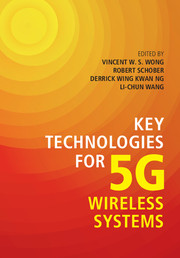Book contents
- Frontmatter
- Contents
- List of Contributors
- Preface
- 1 Overview of New Technologies for 5G Systems
- Part I Communication Network Architectures for 5G Systems
- Part II Physical Layer Communication Techniques
- 6 Non-Orthogonal Multiple Access (NOMA) for 5G Systems
- 7 Flexible Physical Layer Design
- 8 Distributed Massive MIMO in Cellular Networks
- 9 Full-Duplex Protocol Design for 5G Networks
- 10 Millimeter Wave Communications for 5G Networks
- 11 Interference Mitigation Techniques for Wireless Networks
- 12 Physical Layer Caching with Limited Backhaul in 5G Systems
- 13 Cost-Aware Cellular Networks Powered by Smart Grids and Energy Harvesting
- 14 Visible Light Communication in 5G
- Part III Network Protocols, Algorithms, and Design
- Index
- References
12 - Physical Layer Caching with Limited Backhaul in 5G Systems
from Part II - Physical Layer Communication Techniques
Published online by Cambridge University Press: 28 April 2017
- Frontmatter
- Contents
- List of Contributors
- Preface
- 1 Overview of New Technologies for 5G Systems
- Part I Communication Network Architectures for 5G Systems
- Part II Physical Layer Communication Techniques
- 6 Non-Orthogonal Multiple Access (NOMA) for 5G Systems
- 7 Flexible Physical Layer Design
- 8 Distributed Massive MIMO in Cellular Networks
- 9 Full-Duplex Protocol Design for 5G Networks
- 10 Millimeter Wave Communications for 5G Networks
- 11 Interference Mitigation Techniques for Wireless Networks
- 12 Physical Layer Caching with Limited Backhaul in 5G Systems
- 13 Cost-Aware Cellular Networks Powered by Smart Grids and Energy Harvesting
- 14 Visible Light Communication in 5G
- Part III Network Protocols, Algorithms, and Design
- Index
- References
Summary
Introduction
It is envisioned that the capacity demand in fifth generation (5G) wireless networks will increase by 1000 times before the year 2020, and this huge demand will be fueled by high-definition video and content streaming applications, which not only consume immense wireless bandwidth but also have stringent real-time quality of service (QoS) requirements. Small-cell dense wireless networks are regarded as a key candidate 5G technology to meet such aggressive demand. By dense deployment of small-cell base stations (BSs), the network becomes closer to mobile users, and thus the spectral efficiency per unit area can be significantly improved. Moreover, relay stations (RSs) without wired backhaul can also be deployed to enhance the coverage area and provide signal-to-noise ratio (SNR) gain.
While there are many potential opportunities associated with dense wireless networks, the potential spectrum efficiency gain they can provide is significantly limited by increasingly severe interference due to the densification of BSs. There are several common schemes to mitigate interference. In the strong-interference case, channel orthogonalization, such as frequency division multiple access (FDMA) or time division multiple access (TDMA), is used to avoid interference [1], and advanced schemes, such as interference alignment (IA) [2, 3] and interference coordination [4, 5], have been proposed to increase the spectral efficiency of interference channels by jointly mitigating the interference using shared channel state information (CSI). However, these approaches may lead to inefficient use of channel resources because the transmitters do not share payload information and therefore are not fully cooperative. To improve the spectrum efficiency further, coordinated multipoint (CoMP) transmission has been proposed as one of the most important core technologies for Long Term Evolution-Advanced (LTE-A) and future 5G wireless networks [6]. By sharing both CSI and payload data among the BSs concerned, CoMP transmission can transform the wireless network from an unfavorable interference topology to a favorable broadcast topology, where the interference can be mitigated much more efficiently. However, the conventional CoMP scheme is quite costly because it requires a high-capacity backhaul for payload exchange between the BSs, and this poses a huge challenge for practical applications of CoMP, especially for small-cell dense wireless networks.
Information
- Type
- Chapter
- Information
- Key Technologies for 5G Wireless Systems , pp. 236 - 270Publisher: Cambridge University PressPrint publication year: 2017
References
Accessibility standard: Unknown
Why this information is here
This section outlines the accessibility features of this content - including support for screen readers, full keyboard navigation and high-contrast display options. This may not be relevant for you.Accessibility Information
- 1
- Cited by
